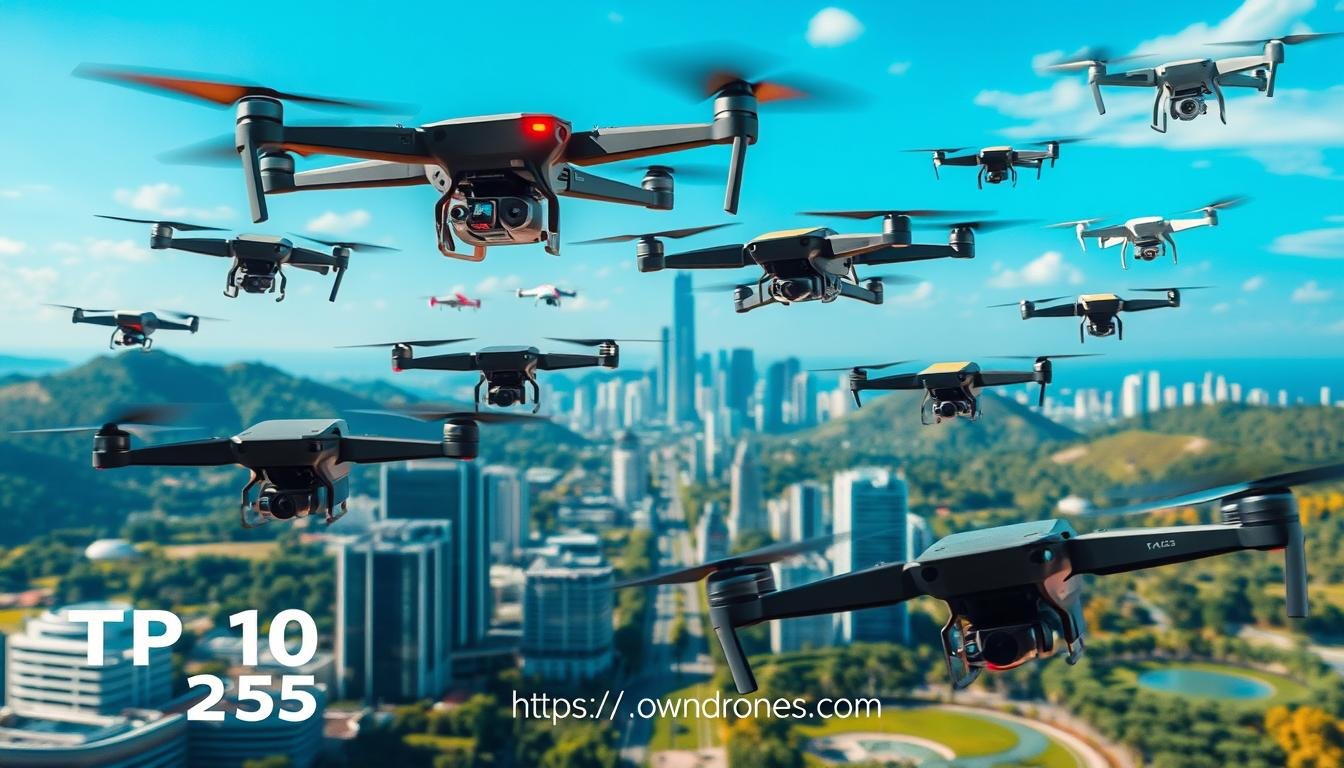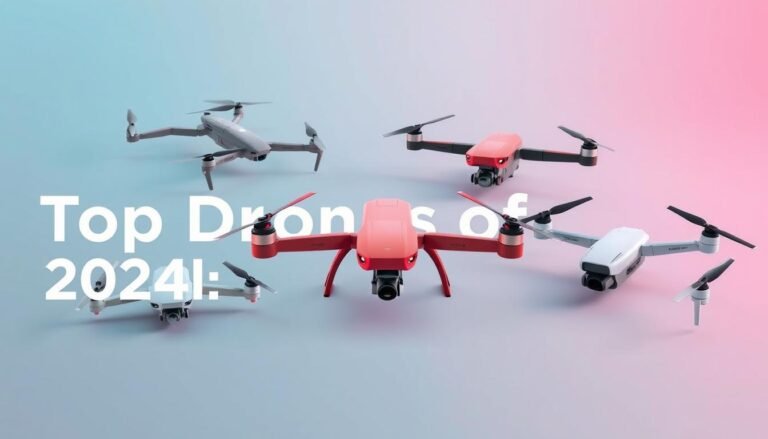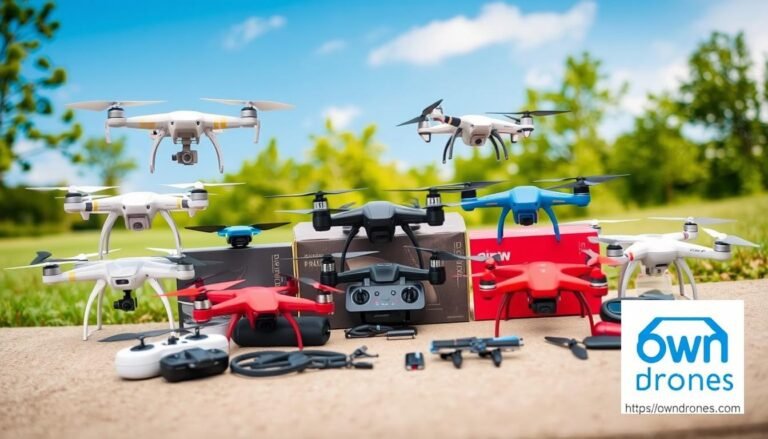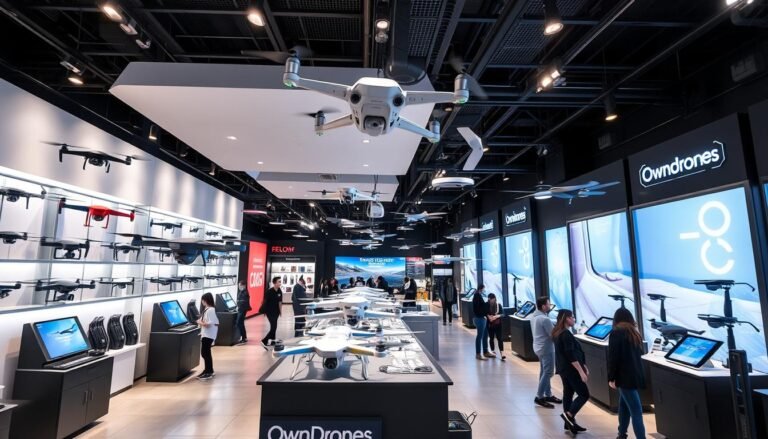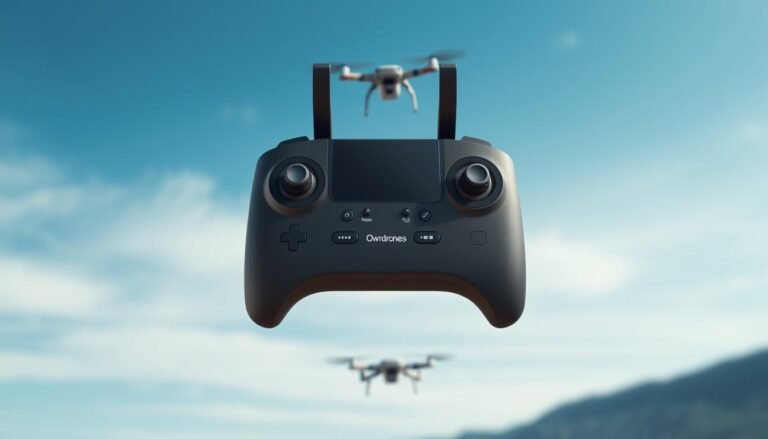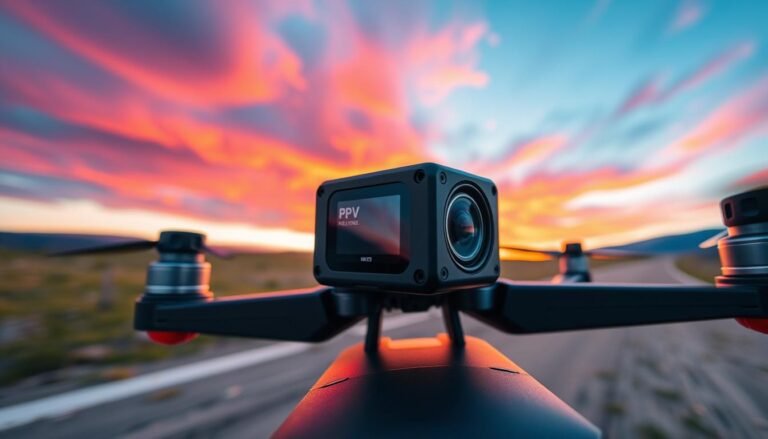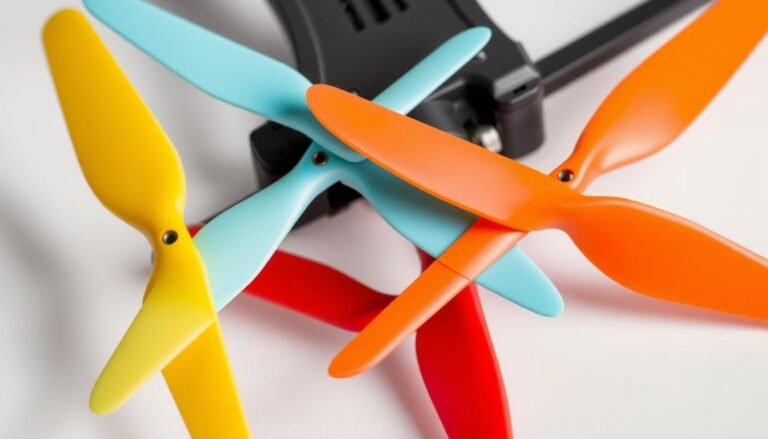Top 10 Best Drones to Buy: A Complete Guide for 2025
Drone technology has advanced rapidly in 2025. Choosing the best drone for your needs can be tough. This guide will help you find the perfect drone for your aerial adventures.
We’ve tested many drones, looking at camera quality, flight performance, and safety features. Our list includes options for beginners and professionals alike. You’ll find drones for photography, videography, racing, and freestyle flying.
Modern drones have cool features like obstacle avoidance and automated flight modes. We’ll discuss flight time, range, and ease of use. We’ll also cover drone regulations and safety tips.
Our top 10 list will help you find your ideal drone. Get ready to capture amazing aerial shots and explore new perspectives. Let’s dive into our expert recommendations for the best drones of 2025.
Key Takeaways
- The DJI Mini 4 Pro is the best overall drone for 2025, offering 360 obstacle avoidance, improved image quality, and a compact design.
- For professional video and cinema, the DJI Mavic 3 Pro stands out with its triple-camera system and advanced features.
- Budget-conscious buyers can consider the DJI Mini 4K, which provides 4K video at an affordable price point.
- The Autel Robotics Evo Lite+ is a worthy competitor to DJI drones, capable of shooting 5.4K footage with a 1-inch sensor.
- Beginners can start their FPV journey with the BetaFPV Cetus Pro Kit, designed specifically for first-person drone flight.
- Always consider factors like camera quality, flight time, range, and ease of use when selecting a drone.
- Be aware of drone regulations in your country and ensure proper registration and insurance coverage.
Introduction to Drones and Their Uses
Drones, or unmanned aerial vehicles (UAVs), have changed how we capture aerial imagery and explore the world. These remote-controlled devices have advanced cameras and sensors for various applications. Let’s explore what drones are and their common uses.
What Are Drones?
Drones are flying machines piloted remotely or programmed to fly on their own. They come in various sizes, from small models for beginners to larger ones for complex tasks.
Modern drones often have high-quality cameras, GPS navigation, and obstacle avoidance systems. These features make them easier and safer to fly than ever before.
Common Applications of Drones
Drones are used in many industries due to their ability to capture stunning aerial images. They can gather data from hard-to-reach places and perform tasks more efficiently than traditional methods.
Some common drone uses include:
- Aerial photography and videography for real estate, weddings, and events
- Mapping and surveying for construction, agriculture, and environmental monitoring
- Inspection of infrastructure, such as bridges, power lines, and wind turbines
- Surveillance and search and rescue operations
- Package delivery and logistics
Benefits of Owning a Drone
Owning a drone can open up new possibilities for hobbyists and professionals alike. It allows you to capture unique perspectives and streamline your workflow.
Key benefits of drone ownership include:
- Capturing stunning aerial photos and videos that would otherwise be impossible or expensive to obtain
- Saving time and money on tasks that traditionally require specialized equipment or personnel, such as roof inspections or crop monitoring
- Exploring new creative possibilities and pushing the boundaries of your photography or videography skills
- Enjoying the thrill of flying and the satisfaction of mastering a new technology
Drone technology keeps advancing, bringing new applications and benefits. This makes drones increasingly valuable for personal and professional use.
Factors to Consider When Buying a Drone
Choosing the right drone involves several key factors. Your needs, budget, and intended use all play crucial roles. Let’s explore the main aspects to consider when selecting your ideal drone.
Purpose and Intended Use
Identify why you want a drone. Are you into aerial photography or videography? Maybe you’re excited about drone racing or freestyle flying.
Your purpose will guide you towards the most suitable drone features. This helps narrow down your options and find the perfect match.
Budget and Price Range
Drones come in various price ranges. Set your budget and look for the best features within that range.
Remember, pricier drones often have advanced capabilities. However, there are great options for those with tighter budgets too.
Camera Quality and Features
For photography enthusiasts, camera quality is crucial. Consider sensor size, resolution, aperture, and stabilization features.
Larger sensors and higher resolutions produce better image quality. Wide apertures improve low-light performance. Gimbal stabilization ensures smooth footage in windy conditions.
The DJI Air 3S has a 48MP camera with a 1/1.28-inch sensor. The DJI Mini 3 features a 1/1.3-inch CMOS sensor with an f/1.7 aperture.
Flight Time and Range
Longer flight times allow for more extensive aerial exploration. Extended ranges let you capture footage from greater distances.
Consider these factors for a better overall experience. They significantly impact your creative freedom and shooting possibilities.
| Drone Model | Maximum Flight Time | Transmission Distance |
|---|---|---|
| DJI Mavic 3 Pro | 43 minutes | N/A |
| DJI Air 3S | 45 minutes | N/A |
| DJI Avata 2 FPV | 24 minutes | 13 km |
| DJI Mini 4 Pro | 34 minutes | 20 km |
Ease of Use and User-Friendliness
New to drones? Look for user-friendly controls and intuitive interfaces. Features like beginner modes and obstacle avoidance can boost your confidence.
The DJI Mini 4 Pro offers omnidirectional obstacle sensing technology. This provides enhanced safety and peace of mind during flight.
Top Drones for Beginners
Choosing the right starter drone can make a big difference in your learning experience. Beginner drones offer easy use and stability. Look for intuitive controls, automated flight modes, and built-in safety features when selecting a drone.
The DJI Mini 2 SE is a top entry-level drone. It’s compact, lightweight, and weighs under 249g. With a 31-minute flight time, you’ll have plenty of practice opportunities.
The Mini 2 SE offers 2.7k video at 30fps and 1080p at 60fps. It also has 3x digital zoom for high-quality images and videos.
The Ryze Tello drone is another great option for beginners. It’s affordable and easy to fly. The Tello has a 13-minute flight time and 100-meter maximum distance.
For more advanced features, consider the DJI Mini 3 and Mini 4 Pro. The Mini 3 has a 38-minute flight time and 4K HDR video capability.
The Mini 4 Pro offers 34 minutes of flight time and 4K 60fps HDR video. It also captures 48MP RAW photos for exceptional image quality.
| Drone Model | Overall Score | Video Quality | Flight Performance | Portability | Ease of Use |
|---|---|---|---|---|---|
| DJI Mavic 3 Pro | 96 | 9.8 | 9.7 | 8.0 | 9.8 |
| DJI Air 2S | 92 | 9.6 | 9.2 | 8.0 | 9.0 |
| DJI Mini 3 Pro | 81 | 7.8 | 8.0 | 10.0 | 8.2 |
| DJI Avata Pro-View Combo | 70 | 6.8 | 6.8 | 9.0 | 6.5 |
| DJI Tello | 40 | 4.2 | 3.0 | 6.5 | 3.8 |
Beginner drones come in various capabilities and price points. The DJI Tello is affordable and portable but scores lower in video quality. More advanced models like the DJI Mini 3 Pro offer better performance.
Your ideal drone depends on your needs, budget, and intended use. Choose wisely to start your aerial photography journey.
Learning to fly a drone can be an incredibly rewarding experience, and with the right beginner-friendly drone, you’ll be capturing stunning aerial footage in no time.
Best Drones for Photography and Videography
Capturing stunning aerial shots requires the right drone. The DJI Mavic 3 Pro and Autel Robotics Evo Lite+ are top choices. These drones offer excellent image quality, advanced features, and user-friendly controls.
DJI Mavic 3 Pro: The Ultimate Aerial Photography Drone
The DJI Mavic 3 Pro boasts a Hasselblad camera with a Four Thirds sensor. It captures vibrant colors and fine details. The drone supports ProRes 422 video, recording cinematic 4K footage.
A 3-axis gimbal ensures smooth footage in challenging conditions. Intelligent flight modes like ActiveTrack and QuickShots enable creative shots. With up to 46 minutes of flight time, you can explore and capture extensively.
Autel Robotics Evo Lite+: A Worthy Competitor
The Autel Robotics Evo Lite+ features a 1-inch sensor camera with adjustable aperture. It adapts well to various lighting conditions. The drone records 6K video, delivering sharp and detailed footage.
| Drone | Camera Resolution | Video Resolution | Flight Time |
|---|---|---|---|
| DJI Mavic 3 Pro | 20MP Four Thirds Sensor | 4K @ 120fps, 5.1K @ 50fps | 46 minutes |
| Autel Robotics Evo Lite+ | 20MP 1-inch Sensor | 6K @ 30fps, 4K @ 60fps | 40 minutes |
The Evo Lite+ has a 3-axis gimbal for stable footage. It offers various intelligent flight modes. Its compact design makes it travel-friendly. With up to 40 minutes of flight time, you can enjoy longer shooting sessions.
Both drones excel in aerial photography and videography. The Mavic 3 Pro shines with its Hasselblad camera. The Evo Lite+ stands out with its adjustable aperture. Either choice will elevate your creative vision.
Best Drones for Racing and Freestyle Flying
Racing and freestyle drones offer an exciting flying experience. These high-speed drones are perfect for acrobatic moves and thrilling competitions. Pilots use first-person view (FPV) goggles for an immersive experience.
DJI Avata 2: The Immersive FPV Experience
The DJI Avata 2 is our top pick for the best overall FPV drone. It’s great for beginners and experienced pilots alike. This compact drone weighs 377g and measures 185 x 212 x 64mm.
The Avata 2 has a 4K camera for stunning footage. It boasts a 23-minute battery life and a 13 km range. With a max speed of 97kph, it’ll satisfy your need for speed.
- Built-in prop guards for enhanced safety
- Intuitive controller for easy piloting
- Compatible with DJI FPV goggles for an immersive experience
BetaFPV Cetus Pro Kit: The Perfect Introduction to FPV
The BetaFPV Cetus Pro Kit is great for FPV beginners. This “Ready to Fly” kit includes everything you need to start. The Cetus drone weighs just 35g and measures 72 x 72 x 20mm.
Key features of the BetaFPV Cetus Pro Kit include:
- Altitude hold function for stable flying
- Durable frame to withstand crashes
- Suitable for both indoor and outdoor flying
When choosing a racing or freestyle drone, look at weight, size, camera, battery life, and speed. The table below compares top FPV drones:
| Drone | Weight | Dimensions | Camera Resolution | Battery Life | Max Speed |
|---|---|---|---|---|---|
| DJI Avata 2 | 377g | 185 x 212 x 64mm | 4K | 23 minutes | 97kph |
| BetaFPV Cetus | 35g | 72 x 72 x 20mm | n/a | n/a | n/a |
| DJI Neo | 135g | n/a | 4K | 15 minutes | n/a |
There’s a racing or freestyle drone for every skill level. Prepare for high-speed, acrobatic drone competitions. Experience the thrill of immersive flying like never before.
Best Compact and Portable Drones
Compact drones have gained popularity among travelers and outdoor enthusiasts. These lightweight models balance performance and portability. They’re perfect for capturing aerial footage on the go.
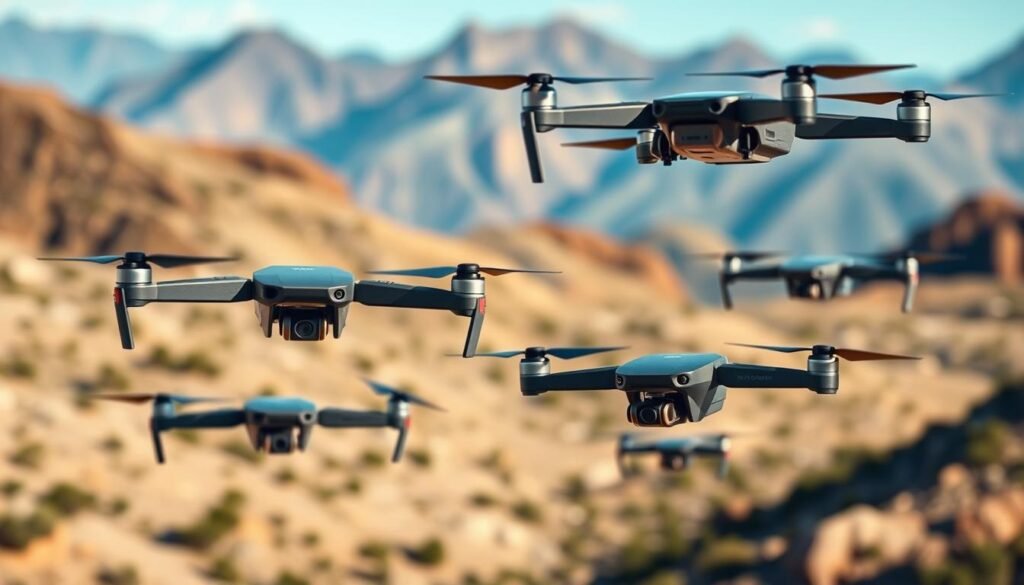
Weight is crucial when choosing a compact drone. Most areas have a 250g (8.8oz) limit for unregistered drones. The DJI Mini 4 Pro weighs just under this limit. It packs impressive features into a tiny package.
DJI Mini 4 Pro: The Ultimate Sub-250g Drone
The DJI Mini 4 Pro is a pocket-sized powerhouse. It offers 4K video quality and up to 31 minutes of flight time. Its 360-degree obstacle avoidance ensures safe flying for all skill levels.
The DJI Mini 4 Pro is the best compact drone under 250g, offering unparalleled performance and features in a tiny package.
Autel Robotics Evo Nano+: A Colorful Alternative
The Autel Robotics Evo Nano+ is a vibrant alternative to DJI drones. It features a 1/1.28-inch sensor for high-quality imagery. With a 4km range and 28-minute flight time, it’s ideal for aerial adventures.
| Drone | Weight | Video Resolution | Flight Time | Range |
|---|---|---|---|---|
| DJI Mini 4 Pro | 249g | 4K@30fps | 31 min | 4km |
| Autel Robotics Evo Nano+ | 249g | 4K@30fps | 28 min | 4km |
Both drones fold down to pocket-friendly sizes for easy carrying. Their lightweight designs and impressive features capture unique perspectives. These mini drones are perfect for preserving life’s memorable moments.
Best Drones for Professionals
Professional drones boast advanced features, long flight times, and tough construction. They’re built for commercial and industrial use in challenging settings. These drones can elevate the work of photographers, videographers, and surveyors.
The DJI Mavic 3 Pro is a top choice for enterprise users. It costs $2,150 on Amazon and has a modular design for various payloads. With a 55-minute flight time and enhanced safety features, it’s a reliable option.
The Mavic 3 Pro shoots 5.1K video and reaches speeds of 46.9 mph. It scored 96 overall, based on video quality, flight performance, portability, and ease of use.
The DJI Air 2S offers great performance at $894 on Amazon. It captures 5.4K video and flies up to 42.5 mph. With an overall score of 92, it’s a strong contender for pros.
For a compact solution, consider the DJI Mini 3 Pro at $719 on Amazon. Weighing under 249g, it’s easier to use under many countries’ drone rules. It shoots 4K video and scored 81 overall.
| Drone Model | Price | Max Video Resolution | Max Speed | Overall Score |
|---|---|---|---|---|
| DJI Mavic 3 Pro | $2,150 | 5.1K | 46.9 mph | 96 |
| DJI Air 2S | $894 | 5.4K | 42.5 mph | 92 |
| DJI Mini 3 Pro | $719 | 4K | 35.8 mph | 81 |
When picking a pro drone, look at camera quality, battery life, and advanced features. Large image sensors and cinema-grade codecs like ProRes can boost footage quality. AI capabilities and subject tracking are also valuable.
The right pro drone can help you capture stunning visuals from unique angles. It’s an investment that can truly transform your work.
Innovative Features in Modern Drones
Drone innovation has soared to new heights. Modern drones now boast advanced technology for aerial photography and videography. These features make flying safer, easier, and more creative than ever before.
Safety systems like obstacle avoidance and collision detection are key advancements. Automated flight modes and intelligent tracking also enhance the drone experience. These improvements allow pilots to focus on capturing stunning aerial footage.
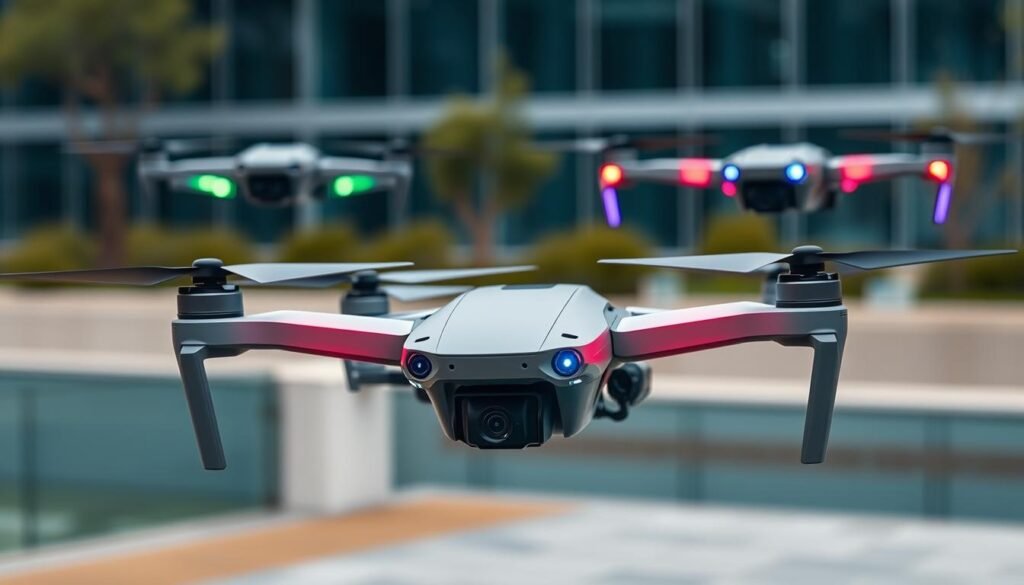
Obstacle Avoidance and Collision Detection
Modern drones use sophisticated sensors to scan their surroundings. These systems detect potential hazards and adjust the drone’s flight path automatically. This technology prevents crashes and ensures safe flights in various environments.
The DJI Mavic 3 Pro is a prime example. It features an omnidirectional obstacle detection system for enhanced safety.
Automated Flight Modes and Intelligent Tracking
These features have changed how pilots capture aerial footage. Drones can now follow subjects, orbit points of interest, or fly along preset paths. The DJI Mavic 3 Pro offers several advanced flight modes:
- Automatic subject tracking (FocusTrack)
- Route planning (Waypoint)
- Cruise control
With these intelligent features, pilots can focus on composition and creativity. The drone handles complex flight maneuvers on its own.
Live Video Transmission and FPV Capabilities
Live video and FPV have transformed the drone flying experience. Pilots now see exactly what the drone sees in real-time. This aids in composition, navigation, and overall control.
The DJI Mavic 3 Pro showcases this technology. It offers an impressive transmission range of up to 15 km with O3+ video transmission.
| Drone Model | Range | Flight Time |
|---|---|---|
| JOUAV CW-30E | 200km (124 miles) | 480 minutes |
| Trinity F90+ | 100km (62 miles) | 90 minutes |
| JOUAV CW-15 | 50km (31 miles) | 180 minutes |
| Autel Dragonfish Pro | 30km (19 miles) | 158 minutes |
| DJI Mavic 3 Pro | 15km (9 miles) | 43 minutes |
Drone technology keeps evolving, promising even more innovative features. Advanced safety systems, automated modes, and immersive FPV capabilities are just the beginning. These improvements empower users to capture stunning visuals from new perspectives.
Drones and Regulations: What You Need to Know
Drones are becoming more popular, making it crucial to understand the drone regulations and drone laws. The Federal Aviation Administration (FAA) oversees drone safety and sets guidelines for responsible drone use in the United States.
Drone registration is a key part of drone regulations. Most drones over 250 grams must be registered with the FAA. Some models are exempt due to their lighter weight. Registration costs $5 and provides an FAA identification number.
Drone pilots must follow specific FAA rules during flight. These include keeping the drone in sight and avoiding airports and people. Knowing these drone restrictions is vital for safe and legal operations.
Commercial drone pilots need a Part 107 remote pilot certificate. This requires passing a 30-minute knowledge test. The certification ensures pilots understand drone safety and responsible drone use.
New drone regulations like Remote ID are being introduced. This feature broadcasts a drone’s position and telemetry for better safety. Many recommended drones already comply with Remote ID requirements.
Staying informed about drone laws, drone registration, and FAA rules is essential. This knowledge helps drone enthusiasts enjoy their devices safely and responsibly. It also keeps the skies open for everyone to use.
Conclusion: Choosing the Best Drone for Your Needs
Selecting the ideal drone requires thoughtful analysis of your needs and budget. Beginners might prefer lighter drones under 250 grams, which are easier to maneuver. The DJI Mini 4 Pro is popular among content creators for its excellent camera and long flight time.
For aerial photography, the Autel Robotics Evo Lite+ offers up to 40 minutes of flight time. Quadcopters are stable, easy to control, and affordable for aerial shots. Entry-level drones cost $500 to $1,000, while mid-range options range from $1,000 to $3,000.
Professional cinematic drones with advanced features can cost $3,000 or more. Prioritize safety features like Return to Home and obstacle avoidance when choosing your drone. Remember to fly responsibly and follow local regulations.
If upgrading, consider selling your old drone online or through trade-in programs. With your perfect drone, you’ll capture stunning aerial visuals and embark on exciting adventures.
